Yi Zou
A Novel Discrete Memristor-Coupled Heterogeneous Dual-Neuron Model and Its Application in Multi-Scenario Image Encryption
May 30, 2025Abstract:Simulating brain functions using neural networks is an important area of research. Recently, discrete memristor-coupled neurons have attracted significant attention, as memristors effectively mimic synaptic behavior, which is essential for learning and memory. This highlights the biological relevance of such models. This study introduces a discrete memristive heterogeneous dual-neuron network (MHDNN). The stability of the MHDNN is analyzed with respect to initial conditions and a range of neuronal parameters. Numerical simulations demonstrate complex dynamical behaviors. Various neuronal firing patterns are investigated under different coupling strengths, and synchronization phenomena between neurons are explored. The MHDNN is implemented and validated on the STM32 hardware platform. An image encryption algorithm based on the MHDNN is proposed, along with two hardware platforms tailored for multi-scenario police image encryption. These solutions enable real-time and secure transmission of police data in complex environments, reducing hacking risks and enhancing system security.
Cross Paradigm Representation and Alignment Transformer for Image Deraining
Apr 23, 2025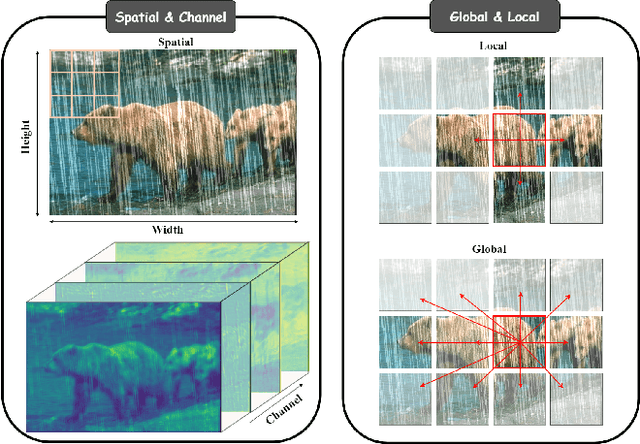
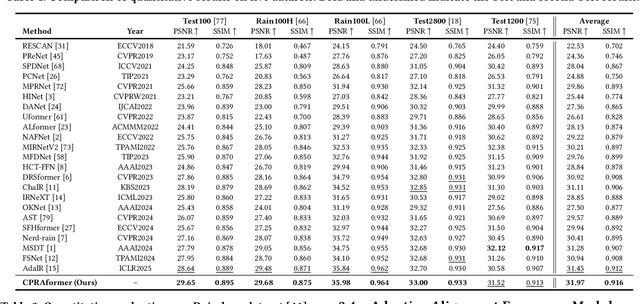
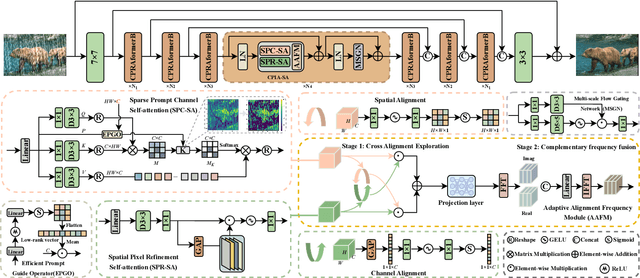
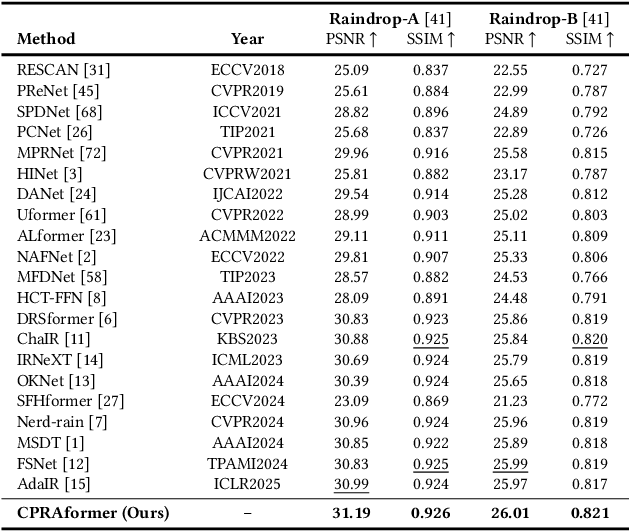
Abstract:Transformer-based networks have achieved strong performance in low-level vision tasks like image deraining by utilizing spatial or channel-wise self-attention. However, irregular rain patterns and complex geometric overlaps challenge single-paradigm architectures, necessitating a unified framework to integrate complementary global-local and spatial-channel representations. To address this, we propose a novel Cross Paradigm Representation and Alignment Transformer (CPRAformer). Its core idea is the hierarchical representation and alignment, leveraging the strengths of both paradigms (spatial-channel and global-local) to aid image reconstruction. It bridges the gap within and between paradigms, aligning and coordinating them to enable deep interaction and fusion of features. Specifically, we use two types of self-attention in the Transformer blocks: sparse prompt channel self-attention (SPC-SA) and spatial pixel refinement self-attention (SPR-SA). SPC-SA enhances global channel dependencies through dynamic sparsity, while SPR-SA focuses on spatial rain distribution and fine-grained texture recovery. To address the feature misalignment and knowledge differences between them, we introduce the Adaptive Alignment Frequency Module (AAFM), which aligns and interacts with features in a two-stage progressive manner, enabling adaptive guidance and complementarity. This reduces the information gap within and between paradigms. Through this unified cross-paradigm dynamic interaction framework, we achieve the extraction of the most valuable interactive fusion information from the two paradigms. Extensive experiments demonstrate that our model achieves state-of-the-art performance on eight benchmark datasets and further validates CPRAformer's robustness in other image restoration tasks and downstream applications.
Learning Dual-Domain Multi-Scale Representations for Single Image Deraining
Mar 15, 2025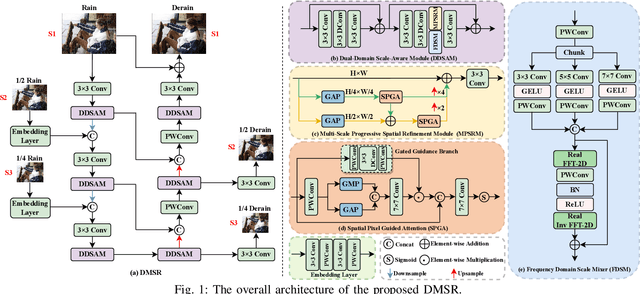
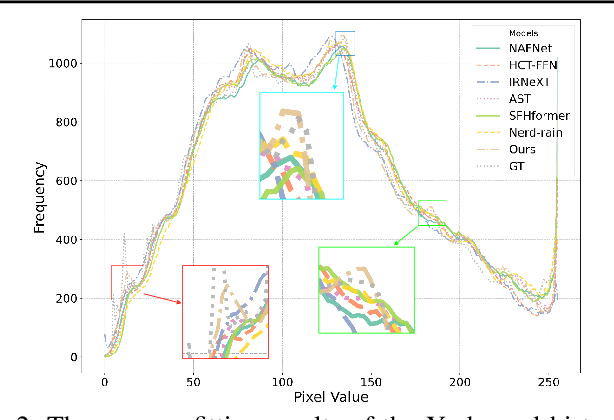
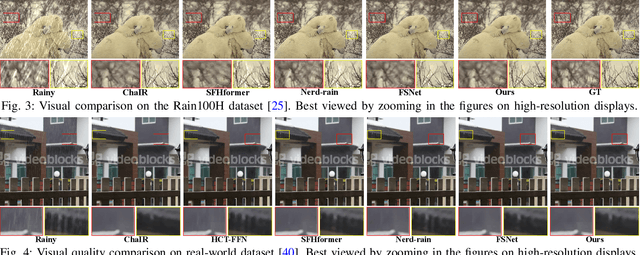
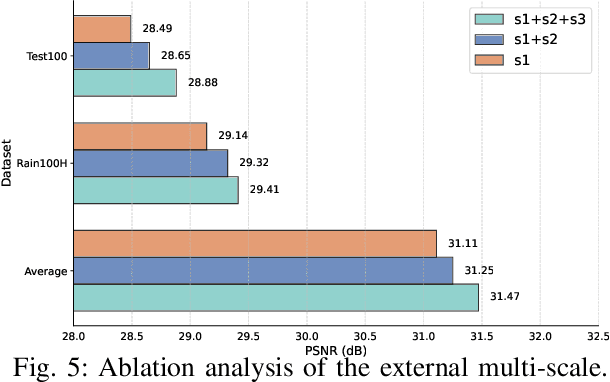
Abstract:Existing image deraining methods typically rely on single-input, single-output, and single-scale architectures, which overlook the joint multi-scale information between external and internal features. Furthermore, single-domain representations are often too restrictive, limiting their ability to handle the complexities of real-world rain scenarios. To address these challenges, we propose a novel Dual-Domain Multi-Scale Representation Network (DMSR). The key idea is to exploit joint multi-scale representations from both external and internal domains in parallel while leveraging the strengths of both spatial and frequency domains to capture more comprehensive properties. Specifically, our method consists of two main components: the Multi-Scale Progressive Spatial Refinement Module (MPSRM) and the Frequency Domain Scale Mixer (FDSM). The MPSRM enables the interaction and coupling of multi-scale expert information within the internal domain using a hierarchical modulation and fusion strategy. The FDSM extracts multi-scale local information in the spatial domain, while also modeling global dependencies in the frequency domain. Extensive experiments show that our model achieves state-of-the-art performance across six benchmark datasets.
Fraesormer: Learning Adaptive Sparse Transformer for Efficient Food Recognition
Mar 15, 2025Abstract:In recent years, Transformer has witnessed significant progress in food recognition. However, most existing approaches still face two critical challenges in lightweight food recognition: (1) the quadratic complexity and redundant feature representation from interactions with irrelevant tokens; (2) static feature recognition and single-scale representation, which overlook the unstructured, non-fixed nature of food images and the need for multi-scale features. To address these, we propose an adaptive and efficient sparse Transformer architecture (Fraesormer) with two core designs: Adaptive Top-k Sparse Partial Attention (ATK-SPA) and Hierarchical Scale-Sensitive Feature Gating Network (HSSFGN). ATK-SPA uses a learnable Gated Dynamic Top-K Operator (GDTKO) to retain critical attention scores, filtering low query-key matches that hinder feature aggregation. It also introduces a partial channel mechanism to reduce redundancy and promote expert information flow, enabling local-global collaborative modeling. HSSFGN employs gating mechanism to achieve multi-scale feature representation, enhancing contextual semantic information. Extensive experiments show that Fraesormer outperforms state-of-the-art methods. code is available at https://zs1314.github.io/Fraesormer.
GIMS: Image Matching System Based on Adaptive Graph Construction and Graph Neural Network
Dec 24, 2024



Abstract:Feature-based image matching has extensive applications in computer vision. Keypoints detected in images can be naturally represented as graph structures, and Graph Neural Networks (GNNs) have been shown to outperform traditional deep learning techniques. Consequently, the paradigm of image matching via GNNs has gained significant prominence in recent academic research. In this paper, we first introduce an innovative adaptive graph construction method that utilizes a filtering mechanism based on distance and dynamic threshold similarity. This method dynamically adjusts the criteria for incorporating new vertices based on the characteristics of existing vertices, allowing for the construction of more precise and robust graph structures while avoiding redundancy. We further combine the vertex processing capabilities of GNNs with the global awareness capabilities of Transformers to enhance the model's representation of spatial and feature information within graph structures. This hybrid model provides a deeper understanding of the interrelationships between vertices and their contributions to the matching process. Additionally, we employ the Sinkhorn algorithm to iteratively solve for optimal matching results. Finally, we validate our system using extensive image datasets and conduct comprehensive comparative experiments. Experimental results demonstrate that our system achieves an average improvement of 3.8x-40.3x in overall matching performance. Additionally, the number of vertices and edges significantly impacts training efficiency and memory usage; therefore, we employ multi-GPU technology to accelerate the training process. Our code is available at https://github.com/songxf1024/GIMS.
Microscopic-Mamba: Revealing the Secrets of Microscopic Images with Just 4M Parameters
Sep 12, 2024



Abstract:In the field of medical microscopic image classification (MIC), CNN-based and Transformer-based models have been extensively studied. However, CNNs struggle with modeling long-range dependencies, limiting their ability to fully utilize semantic information in images. Conversely, Transformers are hampered by the complexity of quadratic computations. To address these challenges, we propose a model based on the Mamba architecture: Microscopic-Mamba. Specifically, we designed the Partially Selected Feed-Forward Network (PSFFN) to replace the last linear layer of the Visual State Space Module (VSSM), enhancing Mamba's local feature extraction capabilities. Additionally, we introduced the Modulation Interaction Feature Aggregation (MIFA) module to effectively modulate and dynamically aggregate global and local features. We also incorporated a parallel VSSM mechanism to improve inter-channel information interaction while reducing the number of parameters. Extensive experiments have demonstrated that our method achieves state-of-the-art performance on five public datasets. Code is available at https://github.com/zs1314/Microscopic-Mamba
ESGReveal: An LLM-based approach for extracting structured data from ESG reports
Dec 25, 2023Abstract:ESGReveal is an innovative method proposed for efficiently extracting and analyzing Environmental, Social, and Governance (ESG) data from corporate reports, catering to the critical need for reliable ESG information retrieval. This approach utilizes Large Language Models (LLM) enhanced with Retrieval Augmented Generation (RAG) techniques. The ESGReveal system includes an ESG metadata module for targeted queries, a preprocessing module for assembling databases, and an LLM agent for data extraction. Its efficacy was appraised using ESG reports from 166 companies across various sectors listed on the Hong Kong Stock Exchange in 2022, ensuring comprehensive industry and market capitalization representation. Utilizing ESGReveal unearthed significant insights into ESG reporting with GPT-4, demonstrating an accuracy of 76.9% in data extraction and 83.7% in disclosure analysis, which is an improvement over baseline models. This highlights the framework's capacity to refine ESG data analysis precision. Moreover, it revealed a demand for reinforced ESG disclosures, with environmental and social data disclosures standing at 69.5% and 57.2%, respectively, suggesting a pursuit for more corporate transparency. While current iterations of ESGReveal do not process pictorial information, a functionality intended for future enhancement, the study calls for continued research to further develop and compare the analytical capabilities of various LLMs. In summary, ESGReveal is a stride forward in ESG data processing, offering stakeholders a sophisticated tool to better evaluate and advance corporate sustainability efforts. Its evolution is promising in promoting transparency in corporate reporting and aligning with broader sustainable development aims.
SleepEGAN: A GAN-enhanced Ensemble Deep Learning Model for Imbalanced Classification of Sleep Stages
Jul 04, 2023



Abstract:Deep neural networks have played an important role in automatic sleep stage classification because of their strong representation and in-model feature transformation abilities. However, class imbalance and individual heterogeneity which typically exist in raw EEG signals of sleep data can significantly affect the classification performance of any machine learning algorithms. To solve these two problems, this paper develops a generative adversarial network (GAN)-powered ensemble deep learning model, named SleepEGAN, for the imbalanced classification of sleep stages. To alleviate class imbalance, we propose a new GAN (called EGAN) architecture adapted to the features of EEG signals for data augmentation. The generated samples for the minority classes are used in the training process. In addition, we design a cost-free ensemble learning strategy to reduce the model estimation variance caused by the heterogeneity between the validation and test sets, so as to enhance the accuracy and robustness of prediction performance. We show that the proposed method can improve classification accuracy compared to several existing state-of-the-art methods using three public sleep datasets.
MELONS: generating melody with long-term structure using transformers and structure graph
Nov 03, 2021

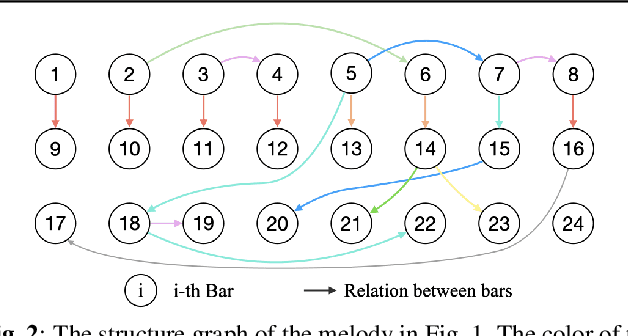
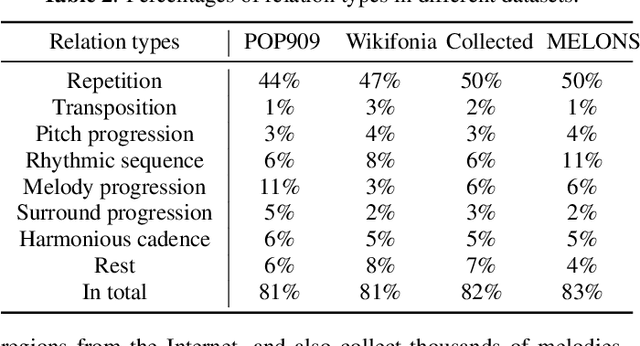
Abstract:The creation of long melody sequences requires effective expression of coherent musical structure. However, there is no clear representation of musical structure. Recent works on music generation have suggested various approaches to deal with the structural information of music, but generating a full-song melody with clear long-term structure remains a challenge. In this paper, we propose MELONS, a melody generation framework based on a graph representation of music structure which consists of eight types of bar-level relations. MELONS adopts a multi-step generation method with transformer-based networks by factoring melody generation into two sub-problems: structure generation and structure conditional melody generation. Experimental results show that MELONS can produce structured melodies with high quality and rich contents.
Context-aware Ensemble of Multifaceted Factorization Models for Recommendation Prediction in Social Networks
May 03, 2021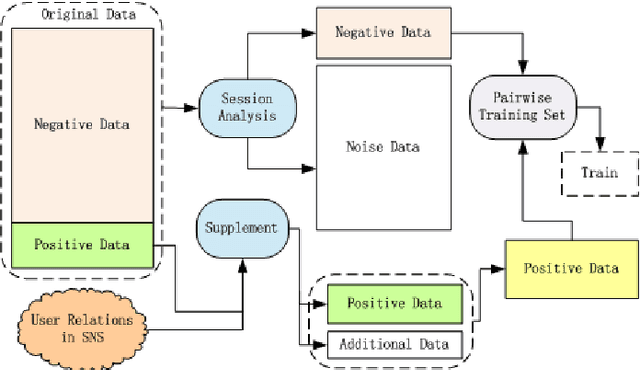
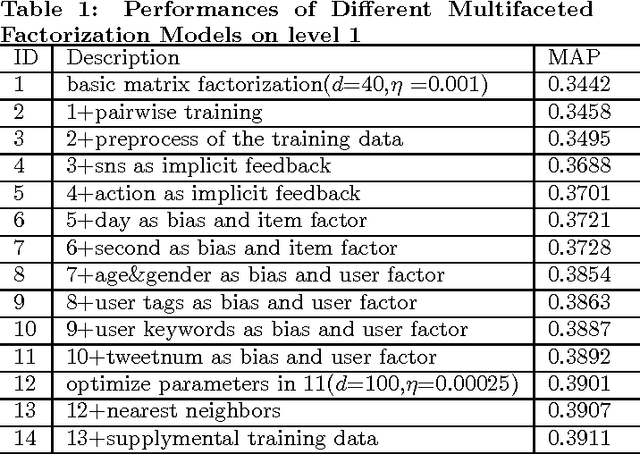
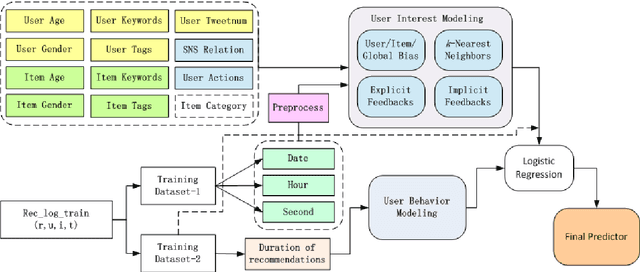
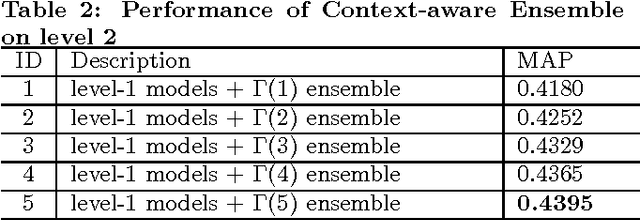
Abstract:This paper describes the solution of Shanda Innovations team to Task 1 of KDD-Cup 2012. A novel approach called Multifaceted Factorization Models is proposed to incorporate a great variety of features in social networks. Social relationships and actions between users are integrated as implicit feedbacks to improve the recommendation accuracy. Keywords, tags, profiles, time and some other features are also utilized for modeling user interests. In addition, user behaviors are modeled from the durations of recommendation records. A context-aware ensemble framework is then applied to combine multiple predictors and produce final recommendation results. The proposed approach obtained 0.43959 (public score) / 0.41874 (private score) on the testing dataset, which achieved the 2nd place in the KDD-Cup competition.
 Add to Chrome
Add to Chrome Add to Firefox
Add to Firefox Add to Edge
Add to Edge